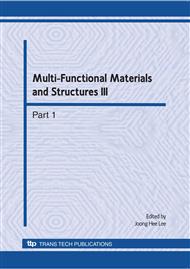p.711
p.715
p.719
p.723
p.727
p.731
p.735
p.739
p.743
Magnetic Properties of Some Hydrated Transition Metal Oxide and Hydroxide Nanoparticles Synthesized in Different Media
Abstract:
Nanoscale particle size of metal oxides and hydroxides showed enhanced various physical properties and performance. We established a simple, cost-effective, room-temperature (RT) precipitation method for the preparation of the magnetic, first-raw transition metal (TM) hydrated oxide and hydroxide nanoparticles. This method is based on the use of the TM nitrate, as the metal source, and cyclohexylamine (CHA), as a precipitating agent, either in the water (H2O) or ethanol (EtOH) medium. We found that the precipitation medium and the identity of precipitated TM strongly affect the morphology, particle size, and magnetism of the product. The morphology varies from spherical, to rectangular, to rod shape; while the size varies in the range of 5-30 nm. All samples showed paramagnetic behavior with Curie temperatures span over a wide range (20-150K). Huge hysteresis looses has been observed for manganese (Mn) sample, prepared in H2O. The coercively (Hc) at 4.2K for this sample is about 1.5T, which is comparable to the strongest permanent magnets (Nd-based magnets) available at room temperature. The energy product (Hc*MR) is about 4.5*105 (emu/g)Oe.
Info:
Periodical:
Pages:
727-730
Citation:
Online since:
August 2010
Price:
Сopyright:
© 2010 Trans Tech Publications Ltd. All Rights Reserved
Share:
Citation:


